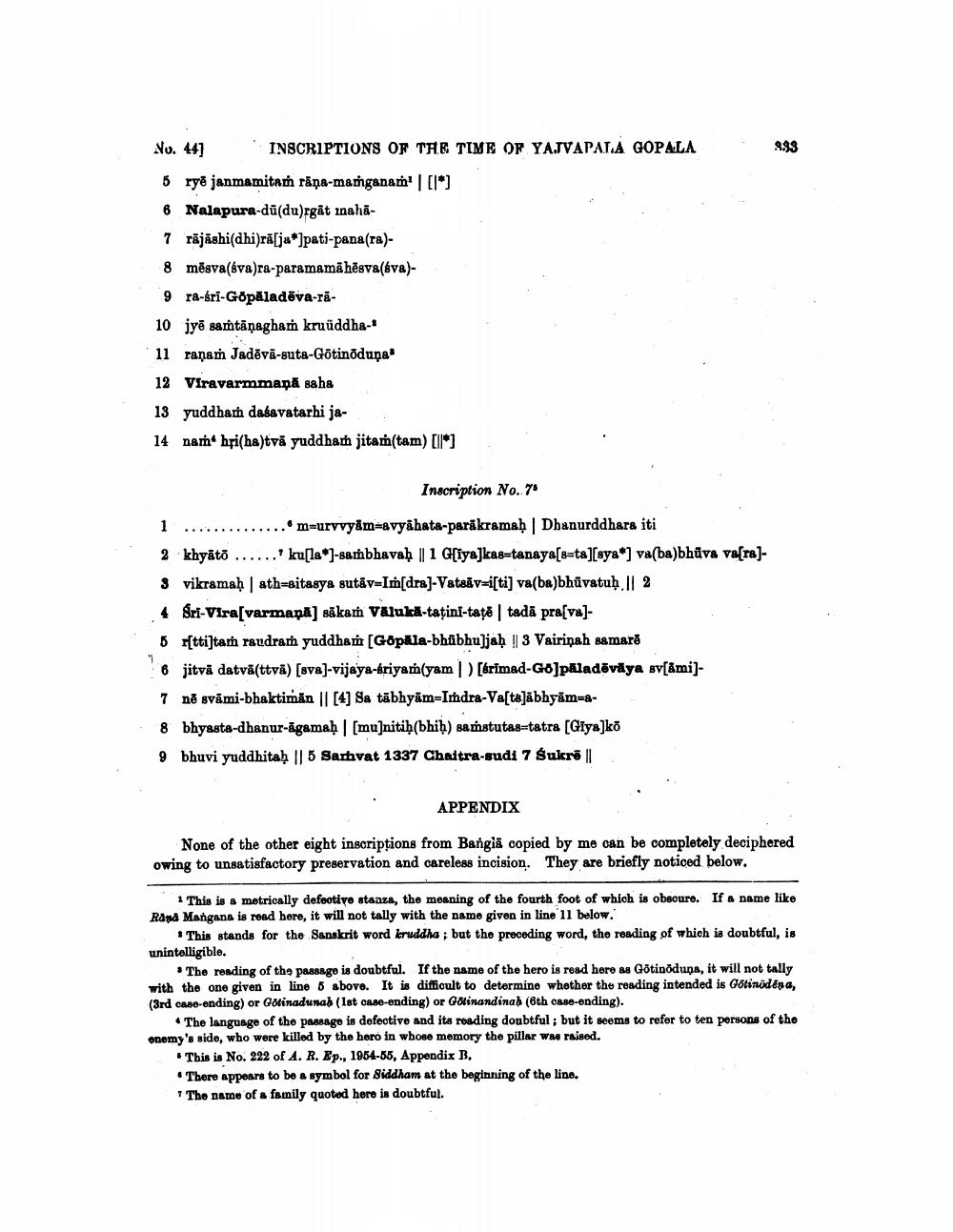________________
9:33
No. 44] INSCRIPTIONS OF THE TIME OF YAJVAPALA GOPALA Bryē janmamitaṁ rāņa-manganam' [l*) 6 Nalapura-dū(du)rgāt naha7 rājāshi(dhi)rā[ja*]pati-pana(ra)8 mēsva(sva)ra-paramamāhēsva(sva)9 ra-sri-Gópăladēva-ra10 jyē samtāṇagham kruüddha-- 11 ranam Jadēvā-suta-Götinoduna. 12 Viravarmmana saha 13 yuddham dabavatarhi ja14 nam hri(ha)tvā yuddham jita(tam) [l*]
tam) (1)
Inscription No.70 1 ...............m=urvvyäm=avyähata-parákramaḥ | Dhanurddhara iti 2 khyāto ......' kulla*)-sambhavaḥ || 1 G[iya]kas=tanaya[s=ta][sya*] vasba)bhūva va[ra]3 vikramaḥ | ath=ritasya sutāv=Im[dra)-Vatsāv=i[ti] va(ba)bhūvatuh. || 2 . 4 Sri-Vira[varmaņā] sākam Valuka-tațini-tatë | tada pra[va)B r [tti]tam raudram yuddham (Gopala-bhübhu]jaḥ || 3 Vairiņah samard 6 jitvå datvästtvā) [sva]-vijaya-sriyam(yam ) [Grimad-G8]paladövāya sv[ämi)7 nð svāmi-bhaktiman || [4] Sa tābhyām=Indra-Va[tájábbyām-a8 bhyasta-dhanur-āgamaḥ | [mu]nitiḥ(bhiḥ) samstutas-tatra (Giya]ko 9 bhuvi yuddhitaḥ || 5 Sarhvat 1337 Chaitra-sudi 7 Sukro ||
APPENDIX
None of the other eight inscriptions from Bangiã copied by me can be completely deciphered owing to unsatisfactory preservation and careless incision. They are briefly noticed below.
1 This is a metrically defective staaze, the meaning of the fourth foot of which is obsoure. If a name like Rand Mangane is read here, it will not tally with the name given in line 11 below.
* This stands for the Sanskrit word kruddha ; but the preceding word, the reading of which is doubtful, is unintelligible.
The reading of the passago is doubtful. If the name of the hero is read here as Götinoduna, it will not tally with the one given in line 5 above. It is difficult to determine whether the reading intended is Gólinodesa, (3rd cano-ending) or Golinadunad (1st case-ending) or Gotinandinak (6th case-ending).
The language of the passage is defective and its reading doubtful; but it seems to refer to ten persons of the onomy's side, who were killed by the hero in whose memory the pillar ww raised.
. This is No. 222 of A. R. Ep., 1964-66, Appendix B. . There appears to be a symbol for Siddham at the beginning of the lino.
The name of a family quoted here is doubtful.




